
COMMUNICATIONS FOR EVERY STAGE OF RUC
As a communications professional, you play an important role in the success of your state’s RUC program. People don’t often want to spend time and money on good communications. Talking to stakeholders and the public about a new funding concept can be uniquely challenging. Effective communications can help address concerns about RUC, close information gaps, and describe RUC program objectives. To help you navigate the process, this section breaks down RUC communications considerations for each stage of RUC.
Click the icons below to learn more about the communications considerations for each stage of RUC.

In the Research and Planning stage, your communications team will focus on creating a communications plan that defines clear goals and objectives for RUC in your state and gathering input. As part of this process, think through how to engage the public, stakeholders, and the media. Tactics may include researching other RUC programs in the country, forming study groups, meeting with stakeholders, conducting public opinion research, and performing additional communications activities.
Some best practices to keep in mind:
- Keep goals simple and measurable.
- Develop a communications plan to guide messaging and engagement.
- Work with RUC program leaders to ensure messaging stays consistent.
- Carry out thorough stakeholder analysis and public opinion research to better understand the prevailing attitudes and concerns in your state.
- Conduct stakeholder interviews with policymakers, advocacy groups, and organizations that serve historically marginalized communities.
- Leverage relationships with existing RUC program sponsors.
- Foster consistent relationships with stakeholders.
- Identify one or more RUC policy champions and work with them to cultivate strong communications practices.
Check out the Building Blocks below to learn more:

In the Setup stage, your communications team will focus on developing a cohesive strategy to support a live RUC program. This means broader outreach to the general public, clear and consistent messaging, and strong coordination with the partner agencies that will share in implementation. You can build on any communications and research you started in the Research and Planning stage or pivot as needed to adjust for evolving needs. Next, develop materials—like a website, frequently asked questions (FAQs), fact sheets, or social media posts—to help the public learn more about the new program. You may find that you need to do more research to get the current pulse of the state and to create additional materials to reflect the latest data.
Some best practices to keep in mind:
- Develop a comprehensive communications strategy to help your RUC program address public concerns.
- Embed equitable engagement practices in all RUC communications.
- Help the public understand which vehicles are included in the new program, and walk drivers through any choices they’ll need to make about mileage reporting or other factors.
- Work to understand and break down barriers to participation for marginalized groups.
- Work with strong champions throughout the state to increase awareness and positive sentiments towards your program.
Check out the Building Blocks below to learn more:

Once your state’s RUC program has been established, your communications strategy will focus on supporting the Ongoing Operations stage. Here, your goal is to keep the public and RUC program participants informed and engaged. Tactics may include maintaining and updating existing program materials, monitoring media coverage, and keeping participants updated about major program news.
Some best practices to keep in mind:
- Revisit and update your communications plan at least once a year to keep things current.
- Keep websites and other materials up to date as the program evolves.
- Develop strategies for addressing emergent communications needs.
- Work with the media and other stakeholders to help keep the public and participants informed.
- Keep working to understand and break down barriers to participation for marginalized groups.
- Message may shift to the benefits that are derived from sustainable transportation funding.
Check out the Building Blocks below to learn more:

As your state prepares to grow its RUC program, you’ll enter the Transitioning and Growing stage. In this stage, you’ll develop a strategy for communicating with the public about program expansions, with a particular focus on prospective participants. Continue to build on previous communications activities, understanding that you may need additional methods to engage new stakeholders and participants.
Some best practices to keep in mind:
- Update your communications plan and conduct additional background research and stakeholder engagement as needed.
- Make sure materials clearly explain the updated program.
- Work with legislators, the media, and other stakeholders to address concerns and to keep the public informed.
- Keep working to understand and break down barriers to participation for marginalized groups.
RUC COMMUNICATIONS RESOURCES AND GO-BYS
Strategic communications that support meaningful engagement between audiences, policymakers, and decision-makers are key to successful RUC program development. Effective messaging and outreach techniques can change public opinion. How to adapt communications at different stages of RUC programs is quickly evolving and informed by ongoing research and lessons learned from many pilot projects and active programs across the country.
The following resources have been curated to provide communication professionals with relevant information for RUC communications and outreach planning, messaging, and materials development. These resources address the full spectrum of RUC stages from different areas of the country, displaying a range of expertise and experience of different states or regions. These resources also represent critical communication topics and commonly used material formats. They include foundational reference documentation as well as “go-by” materials, in physical and online formats, to address a variety of communication and outreach needs.
Active RUC programs
Oregon OReGO Program. Materials provided courtesy of OReGO and the Oregon Department of Transportation. 2018–2022.

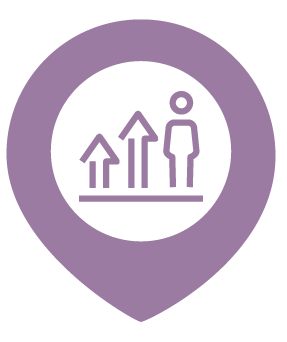
The Oregon Department of Transportation used a varied portfolio of materials to launch its “Keep Oregon Connected” educational campaign in support of the established OReGO program. A press release, fact sheet, presentation, and brochure provide an introduction to RUC, describe how the OReGO program was created and functions, and highlight recent updates for OReGo participants enrolled with hybrid and electric vehicles (EVs). Video reels from the campaign cover general OReGO program promotion, as well as specific topics such as gas tax, pilots, program history, costs, funding, fuel efficiency, and the future of RUC.
- Press release. 2019.
- Fact sheet. 2018.
- Educational presentation. 2019.
- Hybrid and electric vehicle brochure. 2022.
- Video campaign. 2020. (Link to YouTube.)
Utah Department of Transportation Road Usage Charge Program. Fact Sheets and Website. 2019, 2020, 2022.


The Utah Department of Transportation Road Usage Charge website is an intuitive portal to learn more about and enroll in this active program. Utah Department of Transportation began implementing an active RUC program in January 2020, specifically for alternative fuel vehicles (including EVs). The site FAQs and fact sheets provide basic information about the program, such as who is eligible, participant and device information, and how much drivers may anticipate paying with a RUC compared to a gas tax.
Communications strategy
Federal Highway Administration (FHWA). Surface Transportation System Funding Alternatives Phase I Independent Evaluation: Cross-Cutting Report, Chapter 6. Public Outreach, Messaging, and Communication. June 2021.


This chapter from a multi-state cross-cutting evaluation of RUC pilots highlights the value of developing a targeted communications strategy involving messaging around key motivators, communicating to address public concerns, and implementing a multi-pronged approach to outreach and communications. It is a good resource to consider when framing a communications strategy for any RUC stage and includes examples and comparisons of communications and outreach methods explored by different states and coalitions.
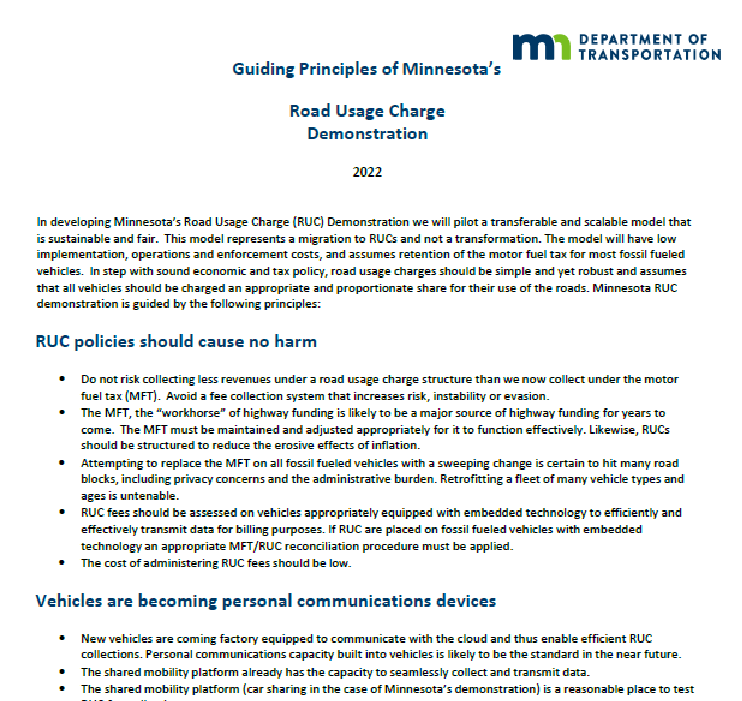
Minnesota Department of Transportation. Guiding Principles of Minnesota’s Road Usage Charge Demonstration. 2022.

This document provides guiding principles for Minnesota’s road usage charge demonstration work. This straightforward guide shows that creating a messaging strategy need not be a complicated endeavor.
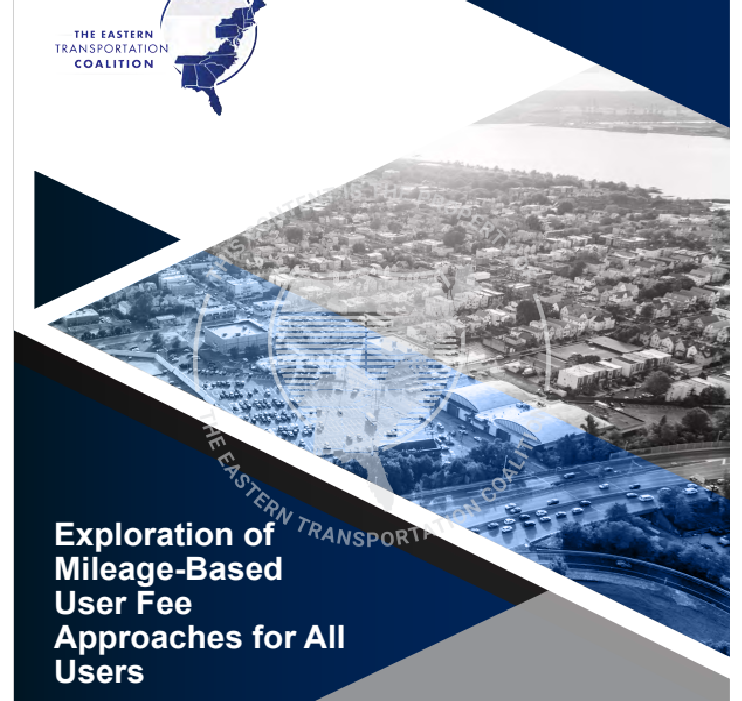
The Eastern Transportation Coalition. Exploration of Mileage-Based User Fee Approaches for All Users. Chapter 9, Key Findings, 9.5 Customized Outreach Needed to Move MBUF Forward. 2022.

The key findings of this report on mileage-based user fees (MBUF) offer an assessment of specific outreach efforts that are needed to advance RUC and engagement strategies that can be incorporated at the research and planning stages to broaden awareness and support. The findings integrate results of public opinion research and stakeholder engagement and spells out specific outreach efforts that will be most effective based on The Eastern Transportation Coalition’s most recent multi-state passenger vehicle pilot and national truck pilot.
Geographic and social equity
RUC America. Fact sheet: Rural Drivers & Communities. July 2018.

This four-page fact sheet/folio addresses common perceptions about equity and rural drivers. It offers compelling graphics demonstrating research related to the number of miles driven by rural and urban drivers, as well as how vehicle type and fuel efficiency affect average charges per month with a gas tax vs. a RUC.

Washington State Transportation Commission. WA RUC Pilot Program: RUC Slides. 2022. | Template Available

These RUC slides provide an overview of Washington State’s RUC exploration and address concerns about issues like privacy and the potential impact of RUC on rural and low-income drivers.
Legislative engagement
National Conference of State Legislatures. State Road Usage Charge Toolkit. April 1, 2022.

This is a useful reference for comparing the approaches different states have taken to implementing RUC programs, which can be important information when engaging with policymakers and legislators. Fact sheets developed for each state include descriptions of project history, legislative activity, and details of their RUC projects. This resource includes profiles for California, The Eastern Transportation Coalition, Hawaii, Minnesota, Missouri, New Hampshire, Oregon, Utah, and Washington.
Oregon Department of Transportation. Legislative Outreach Fact Sheet: Oregon’s Road Usage Charge Program. Materials provided courtesy of OReGO and the Oregon Department of Transportation. February 2022.

This fact sheet was used to engage Oregon legislators and shows the importance of continued legislative education and engagement, even after an active program is established. In addition to background on legislative efforts since 2001 to establish the OReGo program, the brief document includes a description of how the RUC system works in Oregon, highlighting privacy concerns and the program’s practices to protect participants’ data.
Other Sources:
Congress of the United States Congressional Budget Office. Issues and Options for a Tax on Vehicle Miles Traveled by Commercial Trucks. October 2019.
U.S. Government Accountability Office. Highway Trust Fund: Federal Highway Administration Should Develop and Apply Criteria to Assess How Pilot Projects Could Inform Expanded Use of Mileage Fee Systems. January 2022.
Out-of-state drivers
RUC America. Fact Sheet: Measuring Miles Beyond State Borders. How will a Road Usage Charge (RUC) be applied to interstate travel? 2018.

This RUC America fact sheet is an example of how to talk about RUC with regard to interstate travel and provides information about how a cross-border system might work. The fact sheet explains how Washington recently tested interstate operability as part of its RUC pilot, how California similarly tested interstate operability with Oregon in 2015, and how toll system operators are also thinking about how they might work across state lines.
Pilot recruitment and enrollment
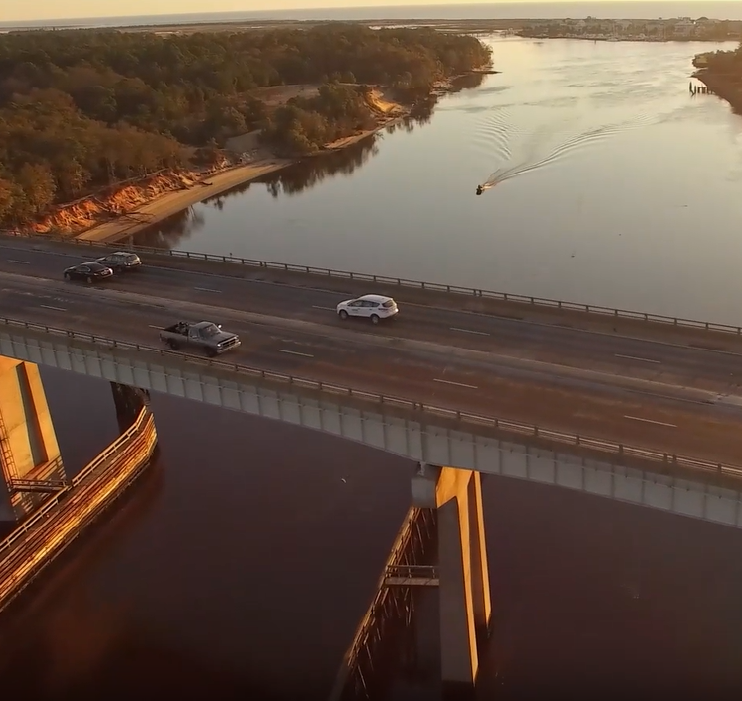
The Eastern Transportation Coalition. Mileage-Based User Fee Pilot Program. 2022.

The Eastern Transportation Coalition’s MBUF pilot program website is focused on recruitment and includes a variety of communication materials to support education around RUC. The site also describes how the pilot works and explains how to enroll. The recruitment site is anchored by videos that provide an overview of MBUF and the purpose of the pilot project.
Washington State Transportation Commission. WA RUC Pilot Program. 2016, 2022.

This series of materials provides insights on Washington State Transportation Commission’s WA RUC Pilot Program. It includes a strategic communications plan that outlines goals and strategies, a recruitment survey to recruit participants in the research study, and a website to discuss project updates.
- WA RUC Communications Plan. 2016.
- WA RUC Recruitment Survey. 2022.
- WA RUC Website: Home Page | FAQs | Pilot Recap Page. 2022.
Privacy
RUC America. Fact Sheet: Data Privacy. 2018.

This four-page fact sheet/folio gives a succinct and visual presentation of the common features of RUC programs with respect to how miles are measured and reported and addresses concerns about the sharing of personal information with states or third-party vendors. This piece emphasizes the choice drivers have to opt-in to different methods of reporting mileage and also explains the data types that are included (e.g., miles driven) and not included (e.g., driver information, location, and speed).

The Eastern Transportation Coalition. Exploration of Mileage-Based User Fee Approaches for All Users. Chapter 9, Key Findings, 9.2 Real-World Pilots Reduce Privacy Concerns. 2022.

This report offers communicators insights on the issues that matter most to users with concerns about privacy and data security, and it discusses the impact of using a pilot participant agreement to build confidence around these issues. Results from TETC’s 2020–21 multi-state passenger vehicle pilots include findings and recommendations from surveys and focus groups related to public perceptions of privacy issues, and consistent data from pre- and post-pilot surveys show a significant decrease in concerns about privacy and security following participation in the pilot projects.
Public opinion
Oregon Department of Transportation. OReGO Education Campaign Evaluation Report. Materials provided courtesy of OReGO and the Oregon Department of Transportation / myOReGO.org. 2020.

This report provides communicators with a view into how a program’s communications planning has adapted and grown through the stages of RUC by employing public opinion research and continual evaluation. Follow-up research for the Oregon OReGo program has continued to focus on public awareness, attitudes, and message testing.
Stakeholder education and outreach
California Department of Transportation. Road Charge Videos. 2021. © California Department of Transportation, 2021. Approved for Transportation Research Board use.

This trio of videos uses fun graphics to explain the concept behind a road charge, how California’s transportation system is funded, and why California is looking to fuel tax alternatives. Appropriate for the general public and stakeholders alike, these videos lay excellent groundwork for discussing the basics with audiences who are new to RUC.
Colorado Department of Transportation. Fact Sheet: Colorado Road Usage Charge. 2016. | Template Available

This document is an example of how to craft a high-level fact sheet for a RUC pilot. It defines RUC, explains the need to address the current transportation funding model, outlines how RUC can address the funding problem, and demonstrates how the pilot program will work.
Hawaii Department of Transportation. Hawaii RUC Demonstration Usage Report Mailer. 2019.

This mailer demonstrates an approach to raising general public awareness about RUC. It uses individualized reporting to educate pilot participants and non-participants about RUC and how it would function for their current registered vehicle, using reported safety inspection data tied to vehicle registration. The mailer includes a set of FAQs and asks recipients to complete a survey on the pilot project website.
Hawaii Department of Transportation. Hawaii RUC Demonstration Project Community Meeting Posters and Presentation. 2019.

Community meetings are an effective tool when higher-touch education and engagement is needed. The Hawaii Department of Transportation developed materials to support a series of meetings as part of its 36-month pilot demonstration project. These materials include a fact sheet, posters, and a meeting presentation with video that addressed background on the purpose and need for RUC and introduced the statewide pilot.
Mileage-Based User Fee Alliance (MBUFA). Website Homepage. 2022.


Using crisp graphics and straightforward messaging, MBUFA’s homepage succinctly explains the concept of a MBUF, or RUC. The page delves into some of the technologies that make RUC possible, as well as why policymakers are exploring RUC as a possible solution to unsustainable transportation revenue.

Minnesota Department of Transportation. Distance-Based Fees Video. 2022.

Using a combination of live and animated images, this video from the Minnesota Department of Transportation explains the concept of distance-based fees and why such fees are needed for the state’s transportation future.
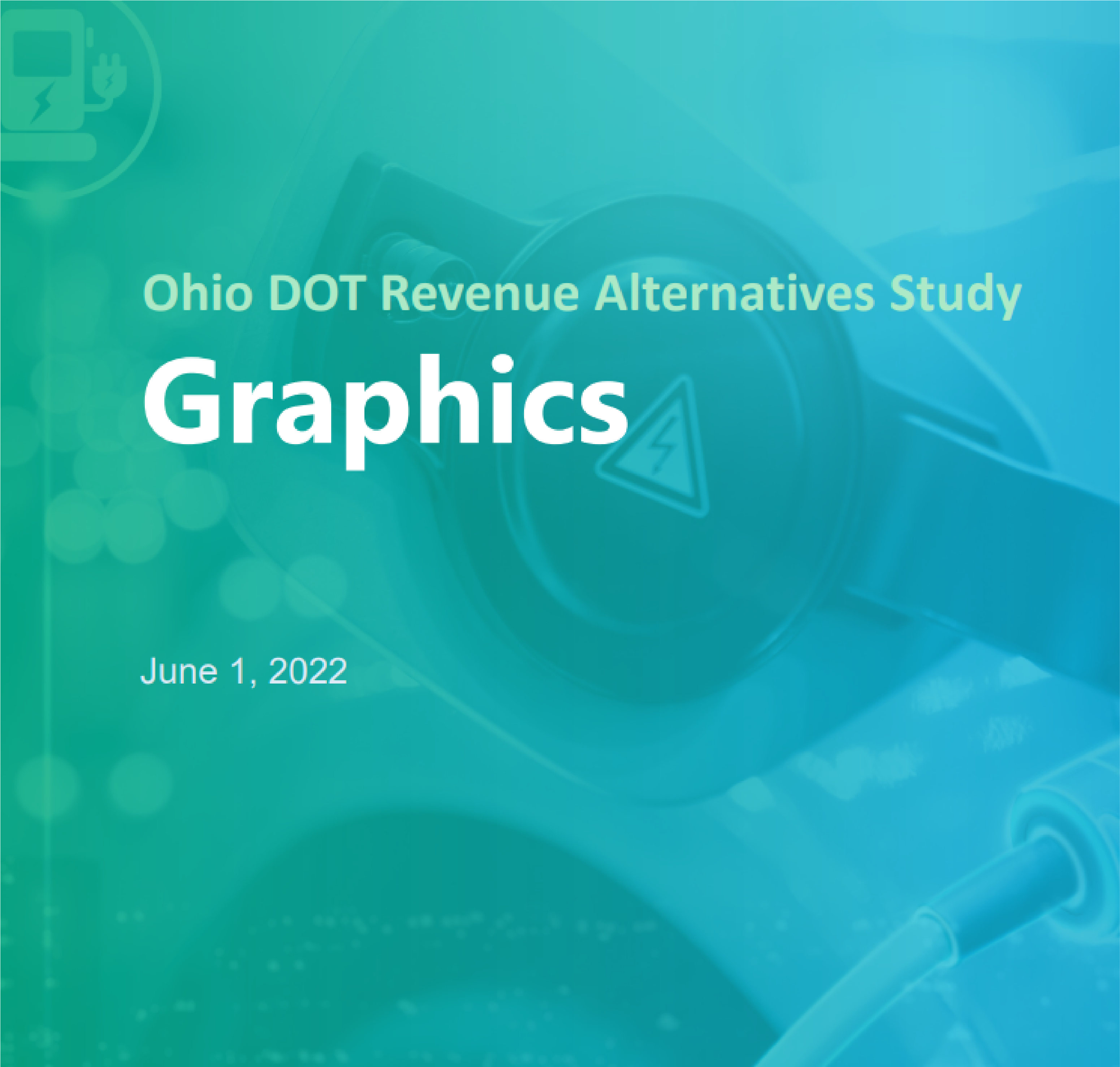
Ohio Department of Transportation. Business Leader Interview Slides. 2022. | Template Available

These PowerPoint slides were used as visual aids during interviews with Ohio business leaders. The slides graphically display the individual impact of various fuel tax revenue alternatives, including RUC.
Pennsylvania Department of Transportation. MBUF Cost Calculator (Screen Recording Demonstration). 2022.

This interactive calculator allows users to input their vehicle data and average miles driven to estimate their MBUF costs. This calculator was developed via a partnership between the Pennsylvania Department of Transportation and The Eastern Transportation Coalition.
Pennsylvania Department of Transportation. Quiz: Test your Mileage-Based User Fee (MBUF) IQ (Screen Recording Demonstration). 2022.

This unique, interactive web feature allows users to explore facts and issues through a quiz format. An alternative to a FAQs list, this web feature raises awareness and educates users on critical issues.
Pennsylvania Department of Transportation. Interactive Game: Can You Close the Gap? (Screen Recording Demonstration) . 2022.

This educational exercise demonstrates the challenge that states have in meeting a transportation funding gap, and it describes the tradeoffs presented by the use of different tools. Participants are asked to manage the transportation funding of a fictional jurisdiction as they manipulate the variables for MBUF, general taxes, corridor tolling, and vehicle fees, building appreciation for the complexity of maintaining our infrastructure.
The Eastern Transportation Coalition. PowerPoint Presentations. 2022.

Presenting on the topic of RUC requires distilling complicated information into digestible takeaways. These slides about MBUF from The Eastern Transportation Coalition show how simple graphics and messaging can help tell the story effectively.
- A Tale of Two Cars Slide comparing the fuel tax paid for a 2009 Toyota Camry versus a 2019 Toyota Camry Hybrid. 2022.
- Looking Across the Borders: Lessons for Implementing MBUF in a Multi-State Environment. 2022.
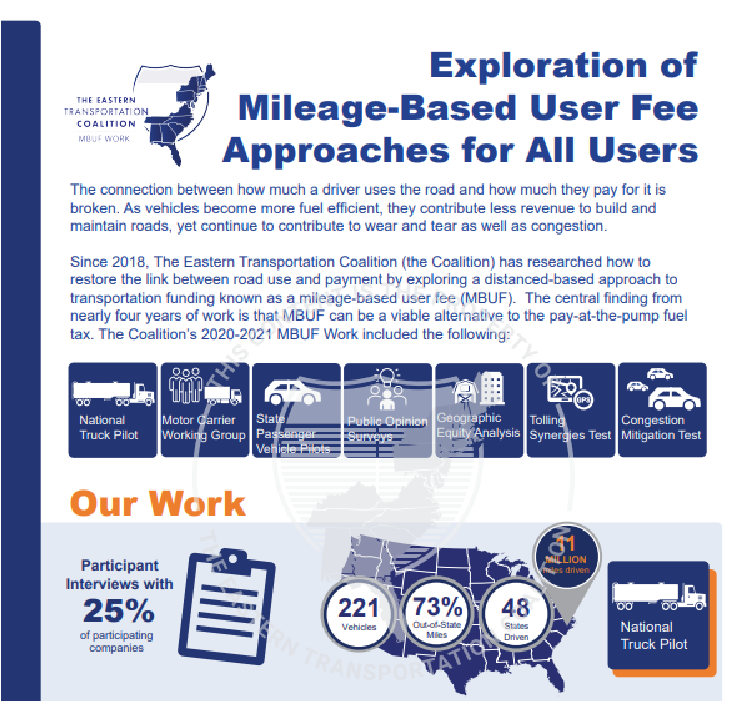
The Eastern Transportation Coalition. Exploration of Mileage-Based User Fee Approaches for All Users Fact Sheet. 2021.

This fact sheet highlights the 5 key findings of The Eastern Transportation Coalition’s 2021 Exploration of Mileage-Based User Fee Approaches for All Users report. Using graphics and simple messaging, the fact sheet addresses the impact of MBUF on rural drivers, attitudes about privacy, and commercial trucks. Additionally, the fact sheet addresses how technology and outreach can be leveraged for MBUF work.
Dive Deeper
Resources for Lead RUC Agencies

